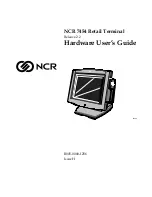
©
National Instruments Corporation
3
SCXI-1328 Installation Guide
Equipment described in this document must be used in an Installation Category II
environment per IEC 664. This category requires local level supply mains-connected
installation.
Do not operate damaged equipment. The safety protection features built into this device
can become impaired if the device becomes damaged in any way. If the device is damaged,
turn the device off and do not use until service-trained personnel can check its safety. If
necessary, return the device to National Instruments for service and repair to ensure that its
safety is not compromised.
Do not operate this equipment in a manner that contradicts the information specified in this
document. Misuse of this equipment could result in a shock hazard.
Terminals are for use only with equipment that has no accessible live parts.
Do not substitute parts or modify equipment. Because of the danger of introducing
additional hazards, do not install unauthorized parts or modify the device. Return the
device to National Instruments for service and repair to ensure that its safety features are
not compromised.
When using the device with high common-mode voltages, you must insulate your signal
wires for the highest input voltage. National Instruments is not liable for any damages or
injuries resulting from inadequate signal wire insulation. Use only 26-14 AWG wire with
a voltage rating of 300 V and 60 °C for measuring up to 300 V.
When connecting or disconnecting signal lines to the SCXI terminal block screw terminals,
make sure the lines are powered off. Potential differences between the lines and the SCXI
ground create a shock hazard while you connect the lines.
Connections, including power signals to ground and vice versa, that exceed any of the
maximum signal ratings on the SCXI device can create a shock or fire hazard or can
damage any or all of the boards connected to the SCXI chassis, the host computer, and the
SCXI device. National Instruments is not liable for any damages or injuries resulting from
incorrect signal connections.
If high voltages (
≥
30 V
rms
and 42.4 V
peak
or 60 VDC) are present, you must connect a safety
earth ground wire to the terminal block safety ground solder lug, shown in Figure 1. This
complies with safety agency requirements and protects against electric shock when the
terminal block is not connected to the chassis. To connect the safety earth ground to the
safety ground solder lug, run an earth ground wire in the cable from the signal source to
the terminal block. National Instruments is not liable for any damages or injuries resulting
from inadequate safety earth ground connections.
Do not loosen or re-orient the safety ground solder lug hardware when connecting the
safety ground wire; to do so reduces the safety isolation between the high voltage and
safety ground.
Clean devices and terminal blocks by brushing off light dust with a soft, nonmetallic brush.
Remove other contaminants with deionized water and a stiff nonmetallic brush. The unit
must be completely dry and free from contaminants before returning to service.
Summary of Contents for SCXI-1328
Page 10: ......




























